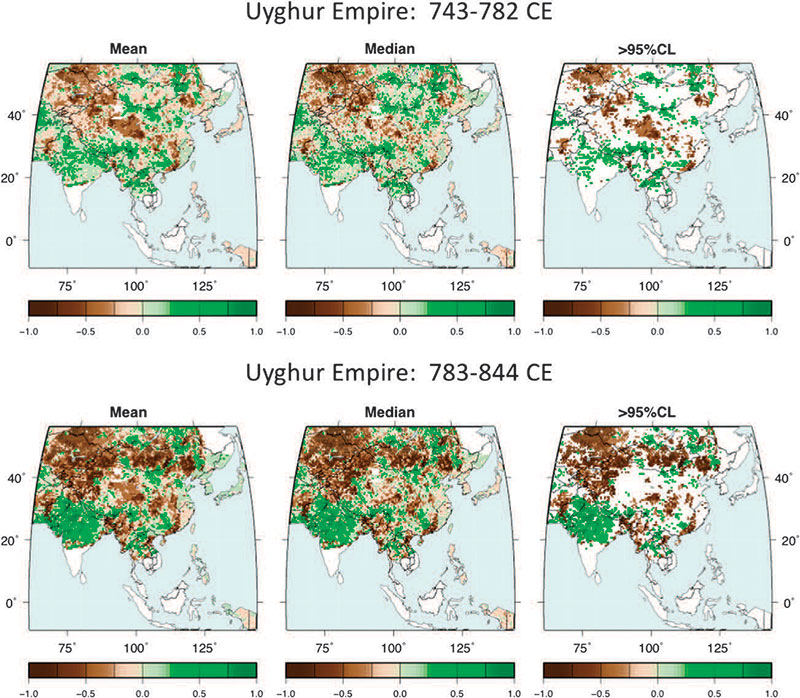Recent paper (behind paywall), Environmental Stress and Steppe Nomads: Rethinking the History of the Uyghur Empire (744–840) with Paleoclimate Data, by Di Cosmo et al. JINH (2018) XLVIII(4):439-463.
Abstract (emphasis mine):
Newly available paleoclimate data and a re-evaluation of the historical and archaeological evidence regarding the Uyghur Empire (744–840)—one of several nomadic empires to emerge on the Inner Asian steppe—suggests that the assumption of a direct causal link between drought and the stability of nomadic societies is not always justified. The fact that a severe drought lasting nearly seven decades did not cause the Uyghur Empire to collapse, to wage war, or to disintegrate gives rise to speculations about which of its characteristics enabled it to withstand unfavorable climatic conditions and environmental change. More broadly, it raises questions about the complex suite of strategies and responses that may have been available to steppe societies in the face of environmental stress.
Interesting excerpts:
The heart of the matter is whether the apparent capacity to withstand adverse climatic conditions was due to a set of cultural and/or political choices, unrelated to climate, or to a modification of their nomadic ways toward a greater reliance on agriculture and trade. In support of the first alternative, the Uyghur Empire’s initial military rise and expansion (c. 744 to 780) may have been aided by conditions of high moisture that would have made the grasslands especially productive. The alliance with China, the conversion to Manichaeism, and the growing incorporation of Sogdian elites in their empire that took place during this period may have aided the Uyghurs, serendipitously, to withstand the climatic crisis. In the long run, however, some areas of society most likely suffered adverse effects, which might explain the internal splits and the final defeat at the hands of the Kirgiz. These developments owe as much to the sedentary habits of the Uyghur elites and their ineffective leadership as to the erosion of the pastoral resources that constituted the main support of a nomadic army.

ring records across Asia.
The evidence from tree-ring data points to environmental conditions that alter the historical narrative of the rise and fall of the Uyghur Empire. Although several studies have focused on how climatic extremes affected agricultural societies, the fate of complex nomadic societies did not necessarily follow the same path. Steppe empires, at least from the first Türk Empire (established in the sixth century C.E.), and possibly earlier, were based on expansive geographical networks, diversified economies, and a degree of co-dependency with merchant classes. Even though these elements varied greatly between empires, they probably reacted to climatic variability in ways radically different from the ways in which agricultural and urban polities did. Once we account for socio-economic complexity, the case of the Uyghur Empire belies the general assumption that nomadic peoples are more vulnerable to climatic stress. The severe and protracted drought did not trigger migration, pillaging, or conquest. Sudden shocks, however, could have had a devastating effect on an economy already weakened.
The catastrophic event of the winter of 839/40, which appears to be a dzud (a weather condition of extreme cold and heavy snowfall that causes high animal mortality) was likely the coup de grâce to an already compromised pastoral production. Contemporary studies of the dzud emphasize that the degree of calamity of the winter disaster is closely related to the drought conditions that preceded it. Thus, the collapse of the Uyghur Empire, generally understood as a rapidly evolving political crisis compounded by a catastrophic weather event, is also connected to multidecadal climatic change, dependency mechanisms, and geopolitical constraints.
I found it interesting mainly because of the potential application of this kind of studies to other previous steppe societies.
Discovered via news on Sapiens.org, posted by Spencer Wells.
Related:
- Ancient nomadic tribes of the Mongolian steppe dominated by a single paternal lineage
- The Lower Danube during the Eneolithic, and the potential Proto-Anatolian community
- On the potential origin of Caucasus hunter-gatherer ancestry in Eneolithic steppe cultures
- Demographic research of Neolithic, Chalcolithic, and Bronze Age Europe
- Model for the spread of Transeurasian (Macro-Altaic) communities with farming
- Y chromosome C2*-star cluster traces back to ordinary Mongols, rather than Genghis Khan
- Expansion of peoples associated with spread of haplogroups: Mongols and C3*-F3918, Arabs and E-M183 (M81)
- Admixture of Srubna and Huns in Hungarian conquerors